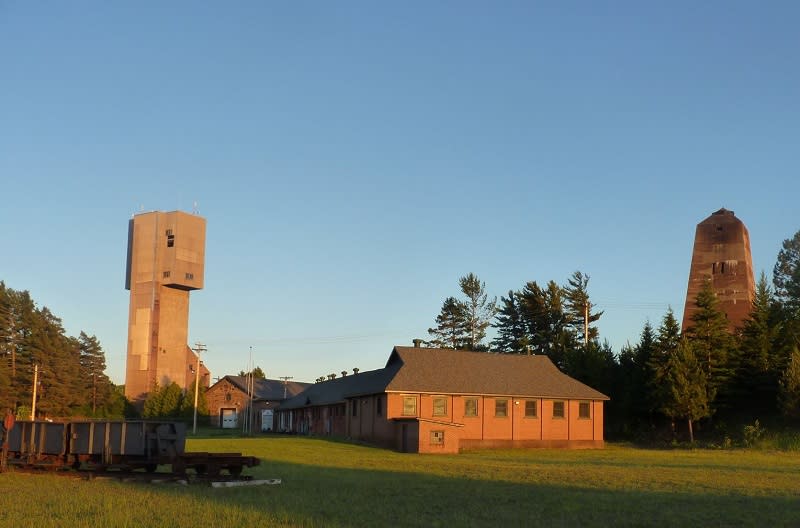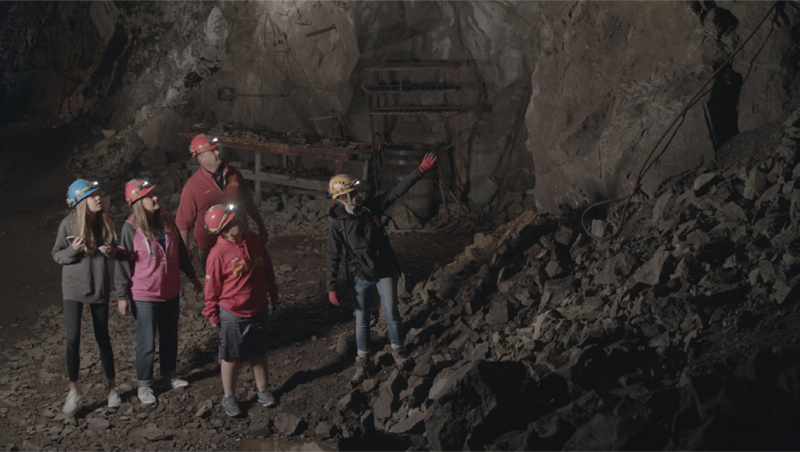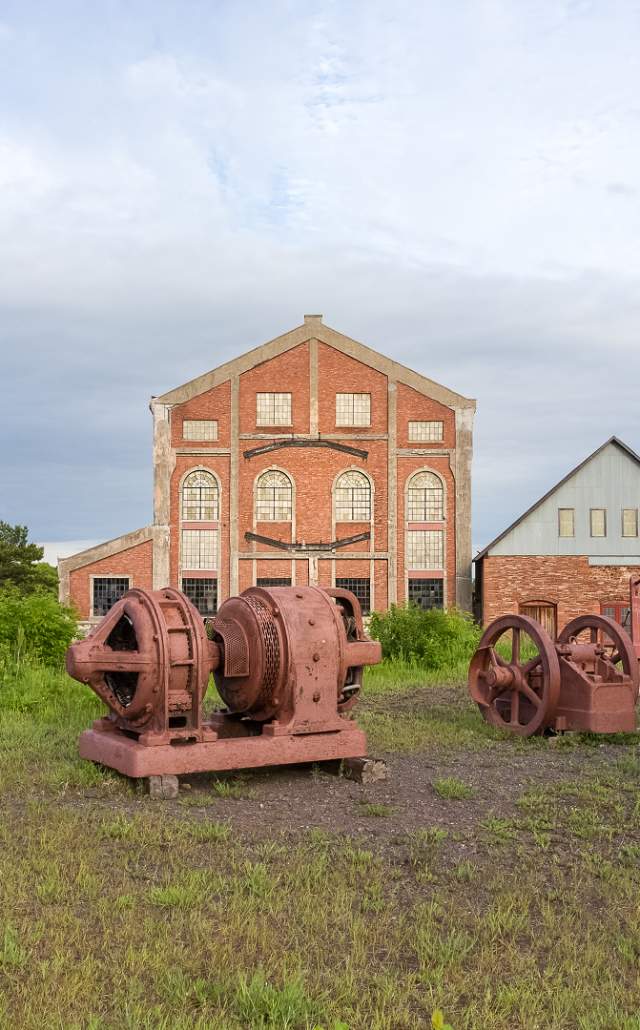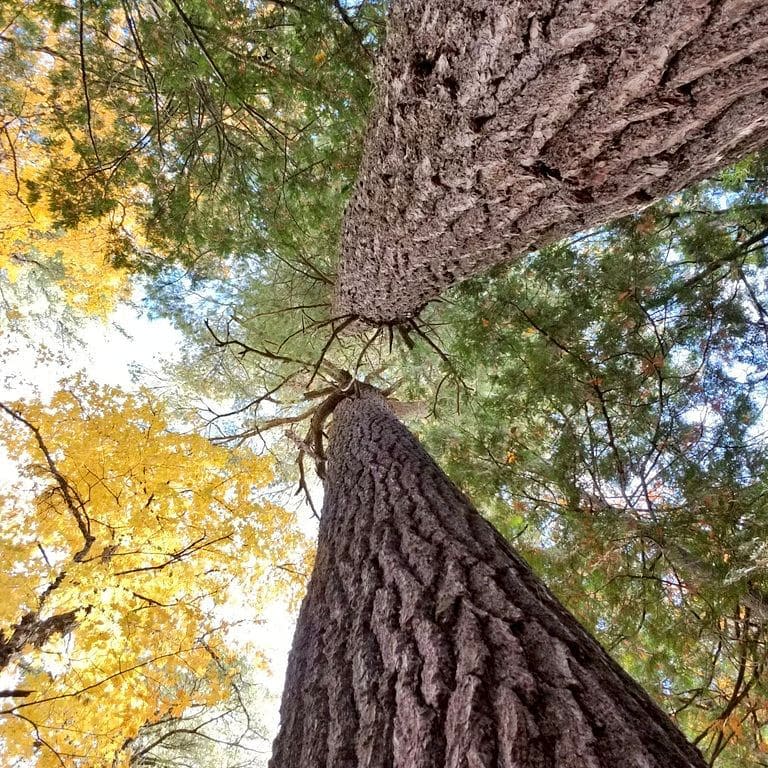Timber, Iron Ore & Copper Mines
As you travel through Michigan’s Upper Peninsula, you may wonder what brought European immigrants to this vast, remote wilderness. It was the prospect of prosperity and wealth — cutting timber, going deep into the earth for iron, copper and some silver, too. It was a hard life for most, but as you walk past the Victorian mansions in Laurium or enter the ornate Calumet Theatre, there is no doubt some became immensely rich from the U.P.’s abundant natural resources.
Hear their stories and experience their lives in many places while you are here. It is worth staying for several days.
We Built America with Our Timber
Today, there are 8.8 million acres of pine and hardwood forests in the U.P. But when the British and French arrived, there were much, much more. These first European arrivals initially used the hardwoods to build forts, ships and other structures. But when waves of European and American loggers, sawyers and investors came in the mid-1800s, the towering white pines became prized trees.
Easy to work with and ship on the Great Lakes, the felled pines built a vast number of houses and buildings in the fast-growing Midwest. They were used to make the once-popular Ford woody wagons and KingsfordⓇ charcoal, too. Decades later, lumber trucks still rumble down U.P. highways, transporting freshly hewn logs to produce building lumber and paper in local mills.
Some of the U.P.’s most colorful characters were the shanty boys, timber barons and townspeople. Learn more about their stories, legendary feats and danger-filled lives at these locations:
-
Tahquamenon Logging Museum, Newberry. Hear about lumberjacks renowned for their grit and brawn. Explore the museum, park and Civil Conservation Corps buildings filled with memorabilia, photos, original logging equipment and more. Watch the Eastern U.P. Events page for the museum’s logging competitions, live demonstrations and Lumberjack Breakfasts (bring a voracious appetite).
-
Paul Bunyan Statues can be seen in two places. The legendary lumberman stands by Babe the Blue Ox at Castle Rock in St. Ignace. Or head to Manistique which claims to be the “Home of Paul Bunyan.” You can’t miss the 15-foot statue towering along US-2. Both sites are great photo opportunities.
-
Iron County Historical Museum, Caspian. It shares stories of lumbering and iron mining.
-
Michigamme Museum, Michigamme. Learn more about Henry Ford’s role in timber harvesting in the U.P. as well as see the “Anatomy of a Murder” display that gives you insight into the number-one bestseller and Academy-award-nominated film.
-
Ontonagon County Historical Museum, Ontonagon. A site in the Keweenaw National Historical Park, it features exhibits showcasing area logging, mining, farming, mariner history and other local historical memorabilia.
Listen to trees whisper memories in their natural settings
-
Estivant Pines Wilderness Nature Sanctuary, Copper Harbor. This is the largest tract of old-growth Eastern White Pines preserved in Michigan. It contains hundreds of trees that are 300-500-years-old, measuring anywhere from 3 to 5 feet in diameter! Walking among these historic giants is rivaled only by the Redwoods in California.
-
Log Slide, Pictured Rocks National Lakeshore. The actual log chute on the dune is gone, but you can stand where lumberjacks once slid logs into Lake Superior. Legend has it that the friction from the logs would catch the chute on fire. If you are tempted to go down to the shore below, remember, it’s a grueling climb up.
-
Historic Sign Walking Tour, St. Ignace. Stop by the “What’s in the water?” interpretive sign along Lake Huron. It explains what the dark debris is along the sandy shore. St. Ignace was a booming lumber and fishing town in the 1870s to mid-1900s.To keep the logs in place before sending them to the mills, they were chained together in the bay. As the waves rubbed the logs together, the bark sank to the bottom. It continues to wash ashore today.
U.P. Iron Ore and Copper Spurred the American Industrial Revolution
While timber was an economic boon to Michigan’s Upper Peninsula, the iron ore and copper rushes put this region on the international map. Pre-dating the California Gold Rush, thousands of prospectors poured into the Marquette, Gogebic and Menominee Iron Ranges and the copper-loaded Keweenaw Peninsula hoping to strike it rich. Bustling towns, iron smelting operations and shipping docks sprang up near these mines. More and more people in Europe and the Eastern U.S. heeded the cry to “Go West, young man” to the U.P. The iron ore and copper they mined built our railroads, bridges, skyscrapers, tools, utensils and Civil War, WWI and WWII weapons.
Iron Ore Mining and Smelting
No one tells about the hardships, dangers, joys and successes of iron ore and copper mining better than the people of the Upper Peninsula. Hear the stories and actually experience what being a miner was like. It’s enthralling.
Mining Tours and Trail

-
Iron Mountain Iron Mine, Iron Mountain. Guided tours take you 2,600 feet through drifts and tunnels to 400-feet below the earth’s surface. Be awed by the amazing rock formations in the large underground lighted caverns. At the end of your tour, enjoy a miner’s lunch, a traditional Cornish pasty.
-
Cliffs Shaft Mining Museum, Ishpeming. Take a guided tour of the tunnels that miners walked to the base of C-Shaft. Listen to what it was like to work the mine from people who did it. See historical displays of past and present headgear, safety equipment, blasting and drilling equipment. Take photos near a 170-ton iron ore truck with its 12-foot high tires or inside the 30-ton shovel bucket!
-
Iron Ore Heritage Trail, Republic to Chocolay. Follow this year-round, 47-mile, multi-use trail. It is designed for walkers, bikers, runners, inline skaters, wanderers, horseback riders, people in wheelchairs, snowmobilers and history buffs. The interpretive trail skirts the 18th- and 19th-century mining pits and hugs Lake Superior’s beautiful shoreline. Experience mining, nature and recreation along the way.
Mining Museums and Iron Smelting Townsites

-
Iron County Historical Museum, Caspian. Considered one of the best historical museums in Michigan, its 26 buildings, artifacts and memorabilia tell the stories of iron mining and lumbering.
-
Cornish Pump & Mining Museum, Iron Mountain. Learn about the Cornish Pumping Engine, the largest standing steam-driven pumping engine ever built in the United States. It is among the largest in the world! This engineering feat was used to dewater one of the wettest iron mines, Iron Mountain’s Chapin Mine.
-
Fayette Historic State Park & Townsite, Garden. If you have never turned off US-2 onto M-183, now is your chance. Drive 17 miles south along the Big Bay de Noc coast to Fayette Historic State Park & Townsite. A ghost of its former self, this was once a booming iron smelting town. Explore 20 buildings and informative displays in the Visitor Center, scuba dive in Snail Shell Harbor to see artifacts or hike, bike or cross-country ski the park’s 3.5 miles of scenic trails. To plan your visit around the park’s planned festivities, stay up-to-date on the Eastern Events page.
-
Menominee Range Historical Museum, Iron Mountain. Over 100 exhibits depict life on the Menominee Iron Range during the 19th to early 20th centuries. A country store, barbershop, doctor’s office, Victorian parlor, moonshine still and folding bathtub are among the historical things you will see.
-
Michigan Iron Industry Museum, Negaunee. This museum overlooking the Carp River is the site of the first iron forge in the Lake Superior region. It offers permanent and temporary exhibits, a video, Iron Spirits: Life on the Michigan Iron Range, plus interpretive outdoor paths.
Copper Mining and Pasties

-
Adventure Mining Company Underground Mining Tours, Greenland. Want to immerse in mining life? Then rappel down a mine shaft, take an underground drilling and blasting workshop or follow a guided tour through the largest rooms in the mine. Tours range from 1.5 to 6 hours. Each one is unforgettable.
-
Caledonia Copper Mine, Mass City. Dig for your own rocks and minerals, and bring home your finds.
-
Copper Range Historical Museum, Houghton. The artifacts will enlighten you about living during the copper rush.
-
Delaware Copper Mine Tours, Mohawk. Walk down 100 feet of stairs through the #1 shaft to the first level of the mine, then continue 1,700 feet through the original workings. Outside, trails take you past the ruins of two original mine buildings, equipment displays, antique engines, trains and animals.
-
Keweenaw National Historical Park. This is one of the best ways to explore the region’s copper mining and cultural heritage. Visit 21 diverse sites including the A.E. Seaman Mineral Museum and Fort Wilkins Historic State Park.
-
Old Victoria Restoration, Rockland. You will discover a wealth of historical items in the cabins. Nearby is where the 3,708-pound “Ontonagon Copper Boulder” was found. You can see it in person the next time you visit the Smithsonian National Museum of Natural History. Plan to attend the Log Cabin Day Celebration in June. Check the Western Events page for the date.
-
Ontonagon County Historical Museum, Ontonagon. Stop in to examine pre-Columbian copper and stone implements, a replica of Ontonagon’s Founder’s Cabin, copper mining tools and displays. Among the exhibits is a model of the “Ontonagon Copper Boulder” so you can visualize how huge it is.
-
Porcupine Mountains Wilderness State Park, Ontonagon. Michigan’s largest state park preserves 60,000 acres of wilderness. It includes copper mining sites such as Nonesuch Mine as well as a 35,000-acre old-growth forest, roaring waterfalls, miles of rivers and streams and more than 90 miles of hiking trails.
-
Quincy Mine Tours, Hancock. Take a guided, 2.25-hour tour through the hoist house, ride a cog-rail tram and enter the mine to see firsthand what this exhausting job entailed. Surface-only tours are also available.
Pasties, throughout the Upper Peninsula. At least one time during your U.P. vacation, eat like a hardrock miner. Cornish immigrants brought their hearty meat and root-vegetable pastry to the U.P. It is said that miners would carry their pasties deep into the earth and heat them in a tin bucket or on a shovel over candle fire. Now you can get a variety of flavors hot-and-ready from numerous shops. Choices range from traditional beef, rutabaga and potatoes to pizza, chicken pot pie, jalapeno or vegetarian. Most pasty makers serve ketchup, gravy, hot sauce or butter on the side.
Taste some of the unique flavors that have found their way up north. From traditional pasties to Southern food to Thai, Michigan’s Upper Peninsula has a wide variety of places to try a new dish or dig into a favorite. These 10 dining locations are just a sliver of the available options.



